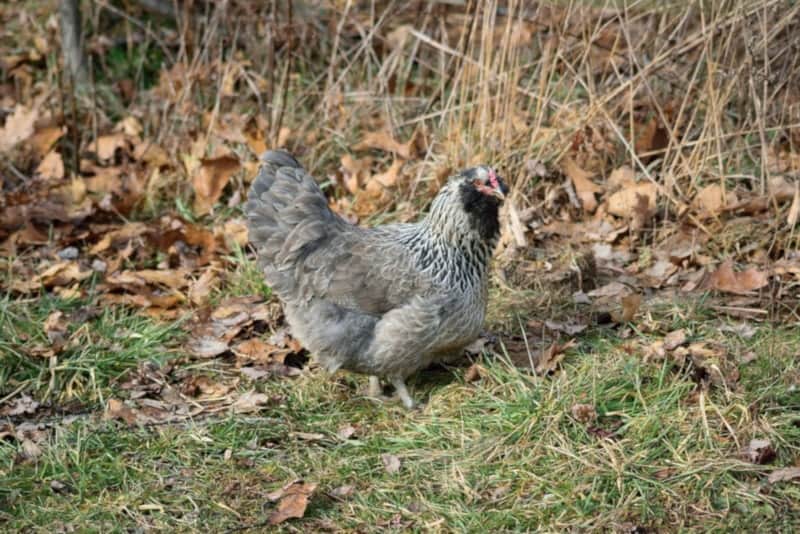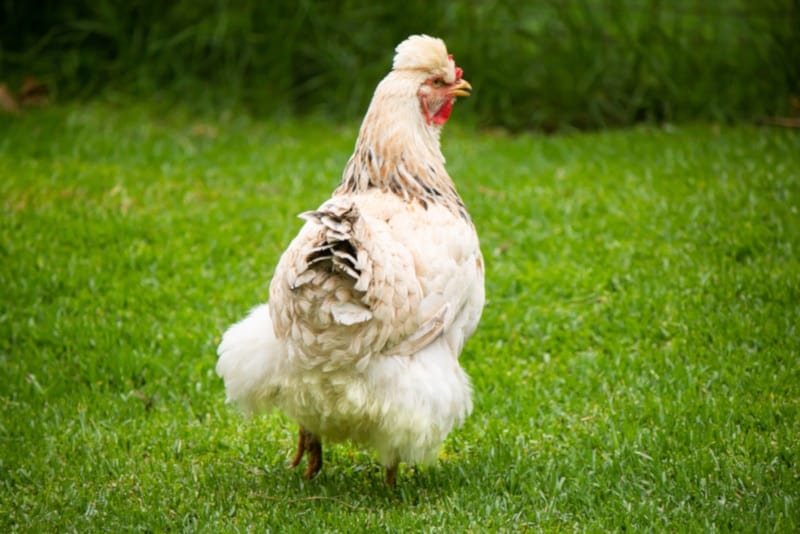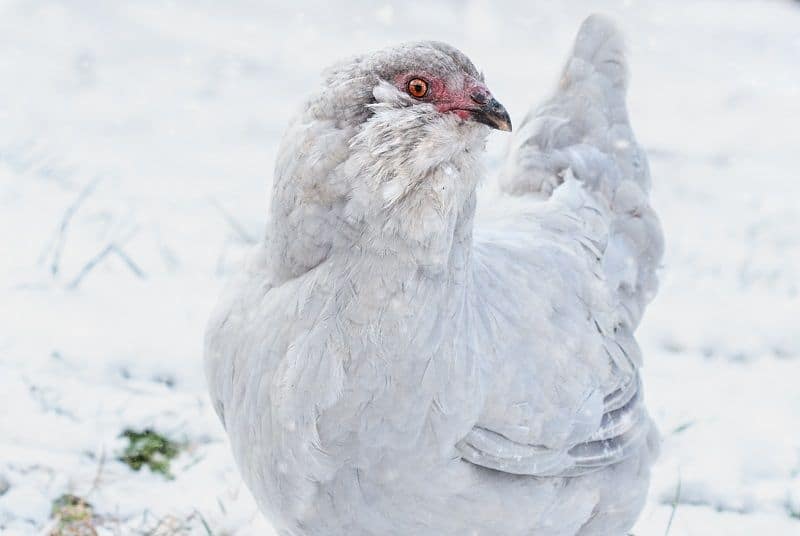The Ameraucana is a new addition to chicken breeds, only making their debut in the mid-1970s. They are hardy, versatile birds that make great pets and backyard layers, laying around three to four blue eggs per week. In general, they are happy, friendly, and social chickens that are great foragers and love to free-range, and they are highly adaptable to confinement.
The Ameraucana has fast become one of the most sought-after breeds in the United States and for good reason. They are a great choice for backyard breeders because they are generally quiet and docile, and they are one of the few chicken breeds that lay beautiful blue eggs. If you are looking at raising your own backyard chicken flock, the Ameraucana is a perfect choice. Read on to find out why!

Quick Facts About the Ameraucana Chicken
Species Name: Gallus gallus domesticus Family: Phasianidae Care Level: Low-moderate Temperament: Calm, docile, gentle, skittish at times Color Form: Black, blue, brown, red, buff, wheaten, white Lifespan: 7-8 years Size: Small, up to 6.5 pounds Diet: Omnivorous forager Minimum Enclosure Size: 4 square feet per chicken Compatibility: Skittish, should be kept away from other animals
Ameraucana Chicken Overview
The Ameraucana Chicken was developed by crossing the Araucana and several other breeds with the intention of removing problematic genetics. The Araucana is a popular South American chicken breed, but due to genetic defects, they have a fairly short life expectancy and are fairly rare. These chickens carry a lethal gene that can kill chicks in the shell.

The result of this cross breeding is a hardy, healthy, and beautiful chicken that retained the Araucana’s unique blue-egg-laying abilities. The Ameraucana is also friendlier and less aggressive than their parent breed, as well as being far longer-lived and free from the deadly genetic defect of the Araucana. After decades of breeding and development — some estimate the breed being around in the United States since the 1920s — the Ameraucana was finally accepted into the American Poultry Association (APA) in 1984.
How Much Do Ameraucana Chickens Cost?
Due to the breed’s growing popularity, the Ameraucana is becoming widely available and fairly inexpensive. Still, they are more expensive than most other backyard breeds, and if you are paying the standard hen price of around $10, the hen is likely not a purebred Ameraucana. For a true, purebred Ameraucana, you are looking at about $20 to $25 for a hen and slightly less for a rooster, roughly $18. These prices also depend on the breeder, the color and lineage of the chicken, and availability.

Typical Behavior & Temperament
Ameraucana Chickens are a great backyard breed because they are generally friendly, docile, and ideal to have around children. They are excellent foragers in hardy to cold climates, if not hot climates, and they do well in confinement, though they much prefer to free-range. They are good layers, and you can expect three to four beautiful blue eggs per week! That said, they do begin laying fairly late, around 5 to 6 months old.
While they are friendly birds in general, they can be skittish at times and easily frightened. For this reason, they are best kept on their own and away from other farm animals, dogs, and cats.

They are fine with humans, although they are not fond of being handled or petted — if you want a chicken that you can cuddle and pet, the Ameraucana is not for you. Males can be aggressive and territorial at times and should be given plenty of space and not be kept in the same coop. One rooster to 10 hens is a good rule of thumb.
Appearance & Varieties
Ameraucanas come in a variety of different colors, and indeed, they are one of the most widely varied chicken breeds in terms of appearance — two Ameraucanas rarely look exactly alike. That said, Ameraucanas all have a distinctive, comical, heavy muff and beard that gives them a puffy, chipmunk-like face! They also have a bright-red pea comb and wattles that are uniquely small, with small red eyes, large blue or black feet, a well-spread tail that is carried upright at a 45-degree angle to their body, white skin, and a distinctively curved beak.
There are several colorations of the Ameraucana recognized by the APA:
- Black
- Blue
- Blue wheaten
- Brown-red
- Buff
- Silver
- Wheaten
- White

Of course, with the growing popularity of the breed and more widespread breeding, more and more unofficial color variations are becoming available, too.

How to Take Care of Ameraucana Chickens
Overall, Ameraucana chickens are robust, hardy animals that can happily live in a wide variety of climates and environments. They are fairly low-maintenance animals that don’t require much specialized care.
Coop
When buying or building a coop for your Ameraucanas, keep in mind that they need a minimum of 4 square feet per chicken, but as always, more is better. Even though they are a relatively small chicken breed, they enjoy more space than other chicken breeds. If they are free-ranging birds, you may be able to get away with slightly less space in their coop. For roosting, aim to have about 8 inches per bird. Keep in mind that in summer, they’ll prefer to be spread out and need slightly more space, whereas in winter, they’ll want to cram together to keep warm. Standard nesting boxes of around 12 x 12 inches are perfect.
Run
Ameraucana chickens love to forage and roam, and although they do well in confinement, they will be far healthier and happier if given freedom and space to roam. A fenced run is a great idea, as this will offer protection from predators and give them their own private space away from other animals on the farm. A good rule of thumb is at least 8 square feet per bird but again, bigger is always better. We highly recommend having a run with an easily movable fence. This will allow you to periodically move the run to new spaces in the garden, offering fresh forage and grass to dig in. If there are no other animals or predators to worry about on your property, free-ranging your Ameraucanas will make for the happiest chickens!

Do Ameraucana Chickens Get Along With Other Pets?
Ameraucanas are generally skittish animals, and as such, they do not get along well with other animals. They are usually fine with other chicken species, but other farm animals like goats or cows and even dogs and cats are likely to scare them, no matter how accustomed they become to them or how friendly the other animals are. This can cause them a ton of stress and will be a detriment to their overall health. We highly recommend keeping your Ameraucanas alone in their own run, away from other animals, with plenty of private spaces to hide and nest in. This way, they will live a peaceful, stress-free life.
What to Feed Your Ameraucana Chicken
Being such expert foragers, Ameraucanas can get a large part of their nutritional needs from forage if they are left to free-range. This also means less feed grain and less expense for you! Alternatively, a standard chicken feed on a free-feeding schedule is fine. All chickens are omnivores and will eat almost anything that they can get their beaks on. Fresh leafy greens, vegetables and fruits, and kitchen scraps are all great additions to their diet that will save you money on feeding costs, too.
In winter, you may have to give them more standard feed than usual, as these contain the added protein, calcium, and vitamins and minerals they need for productive laying when foraging is not an option.
Keeping Your Ameraucana Chicken Healthy
Many people confuse the Ameraucana chicken with their less-healthy ancestor, the Araucana. Unlike their close cousins, Ameraucanas are healthy animals that suffer from few health issues and can live for up to 8 years on average, which is a relatively long lifespan for a chicken. They handle cold climates well because they have small pea combs and wattles, so frostbite is not much of a concern. While they do not handle heat as well as cold, their small size makes them far less prone to overheating than larger breeds.
Breeding
Ameraucana hens are not broody, making them difficult to breed. Also, they will only start producing eggs at around 5 to 7 months, much later than most other breeds. If you want to successfully breed these chickens, you’ll need to invest in an incubator to hatch the eggs, or alternatively, hatch the eggs under a broody hen of another breed. Both these methods are tricky and will take time and experience to perfect. For beginner backyard breeders, you may want to try a broodier chicken breed first.
Most chickens can produce fertilized eggs all year round, but spring is the best time for breeding, especially if you live in a cold climate. As with all chicken breeds, more than one rooster per flock is highly advised against, as this will cause inevitable fights unless they have been raised together and have access to enough hens. In general, a good rule of thumb is around 5 to 10 hens per rooster.

Is an Ameraucana Chicken Suitable for You?
The Ameraucana is a uniquely beautiful and rare chicken breed that makes a great addition to any backyard flock — if you can find any chicks, of course! Their calm and friendly nature, hardy disposition, and general ease of care are all massive advantages for backyard breeders, not to mention their beautiful blue eggs!
Overall, the Ameraucana is a healthy, long-lived, quiet, and efficient forager that will make a wonderful addition to your flock.
Featured Image Credit: Stephanie Frey, Shutterstock
